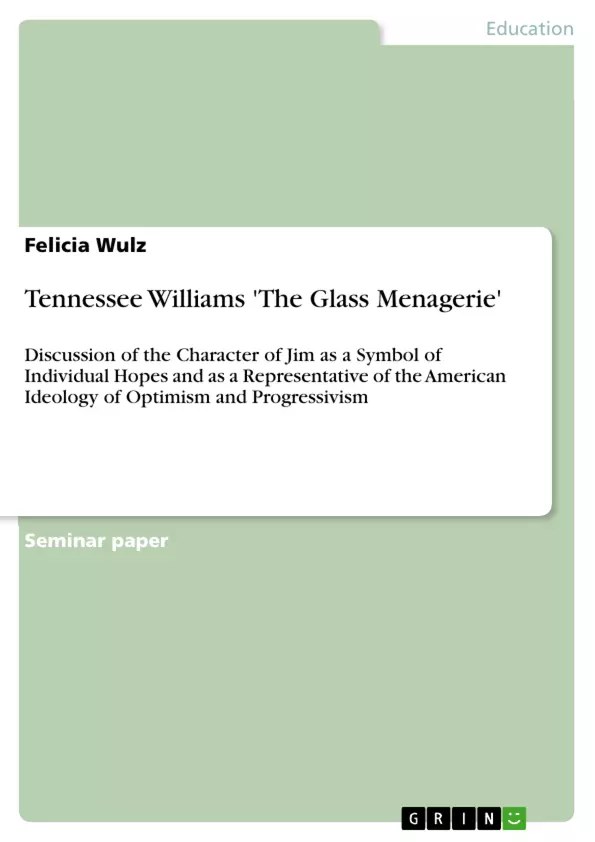The subject of this work is the character of Jim O’Connor in Tennessee Williams’ play The Glass Menagerie . The text discusses the question to what extent he is a symbol of hope for all members of the Wingfield family and of whether he is a representative of the American ideology of optimism and progressivism.
Table of Contents
- 1. Introduction
- 2. Jim as a symbol of individual hopes
- 2.1 Amanda's hopes on Jim
- 2.2 Laura's hopes on Jim
- 2.3 Tom's hopes on Jim
- 3. The American ideology of optimism and progressivism
- 4. Jim O'Connor an optimistic and progressive American?
- 5. Conclusion
Objectives and Key Themes
This work analyzes the character of Jim O'Connor in Tennessee Williams' "The Glass Menagerie," examining his role as a symbol of hope for the Wingfield family and his representation of the American ideology of optimism and progressivism. The analysis explores how Jim embodies these ideals, and the extent to which these hopes are ultimately fulfilled or dashed.
- Jim O'Connor as a symbol of hope for the Wingfield family.
- The contrasting hopes and expectations each family member projects onto Jim.
- The American Dream and its manifestation in Jim's character.
- The interplay between individual hopes and societal ideals.
- The disillusionment and disappointment that result from unmet expectations.
Chapter Summaries
1. Introduction: This introductory chapter sets the stage for the analysis of Jim O'Connor's character in Tennessee Williams' "The Glass Menagerie." It clearly states the central research question: to what extent does Jim represent a symbol of hope for the Wingfield family and the American ideology of optimism and progressivism? This framing establishes the scope and focus of the subsequent analysis, highlighting the dual interpretation of Jim's character as a source of both personal aspiration and broader societal ideals.
2. Jim as a symbol of individual hopes: This chapter delves into the individual hopes each member of the Wingfield family places upon Jim. Amanda, longing for a secure future for her daughter Laura, sees Jim as a potential husband and provider, a chance to escape poverty and uncertainty. Laura, shy and withdrawn, views Jim as a reminder of a past affection and a potential for connection. Tom, burdened by his responsibilities and yearning for escape, sees Jim's potential marriage to Laura as a pathway to freedom and the pursuit of his own dreams. The chapter expertly illustrates how Jim becomes a focal point for the family's collective anxieties and aspirations.
3. The American ideology of optimism and progressivism: This section explores the broader socio-historical context of the play. It examines the ingrained American ideology of optimism and progressivism, tracing its origins from the early settlers and their 'American Dream' to the time period of the play. The chapter emphasizes the belief in self-improvement, hard work leading to success, and the possibility of upward mobility. This sets the stage for analyzing whether or not Jim's character reflects and embodies these ideals, and how those ideals clash with the realities experienced by the Wingfield family.
Keywords
Tennessee Williams, The Glass Menagerie, Jim O'Connor, American Dream, optimism, progressivism, hope, disillusionment, family dynamics, societal expectations, individual aspirations.
Frequently Asked Questions: Analysis of Jim O'Connor in Tennessee Williams' "The Glass Menagerie"
What is the overall focus of this analysis?
This analysis examines the character of Jim O'Connor in Tennessee Williams' "The Glass Menagerie," focusing on his role as a symbol of hope for the Wingfield family and his representation of the American ideology of optimism and progressivism. It explores how Jim embodies these ideals and whether these hopes are ultimately fulfilled or dashed.
What are the key themes explored in this analysis?
The key themes include Jim O'Connor as a symbol of hope; the contrasting hopes and expectations projected onto Jim by each family member; the American Dream's manifestation in Jim's character; the interplay between individual hopes and societal ideals; and the disillusionment and disappointment arising from unmet expectations.
How does the analysis approach the character of Jim O'Connor?
The analysis approaches Jim O'Connor from a dual perspective: as a source of personal aspiration for the Wingfield family and as a representation of broader societal ideals rooted in the American ideology of optimism and progressivism.
What are the main chapters and their respective focuses?
The analysis is structured into several chapters. The introduction sets the stage and research question. Chapter 2 delves into the individual hopes each Wingfield family member places on Jim. Chapter 3 explores the broader socio-historical context of the play, examining the American ideology of optimism and progressivism. The conclusion synthesizes the findings.
How does the analysis interpret Amanda, Laura, and Tom's hopes regarding Jim?
Amanda sees Jim as a potential husband and provider for Laura, a way to escape poverty. Laura views him as a potential connection, reminiscent of a past affection. Tom sees Jim's potential marriage to Laura as a path to his own freedom and the pursuit of his dreams. The analysis highlights how Jim becomes a focal point for the family's collective anxieties and aspirations.
What is the role of the American Dream in this analysis?
The analysis examines the American Dream and its manifestation in Jim's character. It explores the belief in self-improvement, hard work leading to success, and upward mobility, and how these ideals clash with the Wingfield family's realities.
What are the key takeaways regarding Jim O'Connor's role?
The analysis explores whether Jim embodies the American ideals of optimism and progressivism and how those ideals are impacted by the realities of the Wingfield family's situation. The analysis investigates whether Jim fulfills or disappoints the hopes placed upon him.
What are the keywords associated with this analysis?
Keywords include Tennessee Williams, The Glass Menagerie, Jim O'Connor, American Dream, optimism, progressivism, hope, disillusionment, family dynamics, societal expectations, and individual aspirations.
- Quote paper
- Felicia Wulz (Author), 2004, Tennessee Williams 'The Glass Menagerie', Munich, GRIN Verlag, https://www.hausarbeiten.de/document/131443


